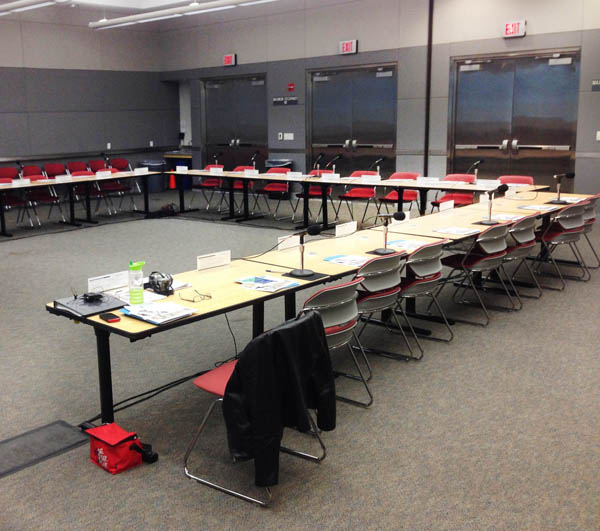
Setting The Table
Another common aspect in corporate audio work is the “table” mic for panel discussions. Banquet tables are placed onstage and handheld mics on desk stands or gooseneck mics are used.
Smaller meetings without audiences may have table mics set up just so the participants can hear each other, and/or the mics feed a recorder (especially common with government and public corporations).
The usual table mic configuration is wireless or wired handheld mics in clips attached to desk stands. Again, it’s best to include windscreens, even if the mics have a good pop filter built in. To reduce table noise, make sure that the desk stands have rubber isolation feet.
For desk stands that have lost their feet, glue felt to the bottom of the stand to provide isolation. One trick I picked up years ago is to place computer mouse pads under the stands to provide an extra layer of isolation.

Gooseneck mics, especially ones with bases, make great table mics, but take care to configure any push-to-talk or mute switches before the event. Most models with switches allow you to configure settings and bypass the switches altogether. The latter is my preferred setting because I don’t like presenters inadvertently turning off mics.
Boundary mics can work great when placed on conference or boardroom tables for recording smaller meetings, but they don’t work as well for PA because most presenters want something that looks like a traditional mic to speak into. Also, table mics are sometimes shared by more than one presenter, so if they’re wired, leave a lot of cable slack so they can move around.
A specialized system for table mic applications is most commonly called a “conference system” and consists of at least one master station with several mic stations. Each station has a push to talk switch, and many models have a light that illuminates near the head to show when a mic is live. The master station, used by the moderator, board chairperson, or sound person, has a mute switch that can shut off some or all mics.
More advanced conference systems include loudspeakers in the bases of the mic stations that work on the mix-minus principle. Each mic is routed to every other loudspeaker except its own. That way, feedback is pretty much eliminated and all participants can clearly hear each other. Some models also include a jack that provides the option of listening to the discussion with headphones or earbuds.
Senior contributing editor Craig Leerman is the owner of Tech Works, a production company based in Las Vegas.
